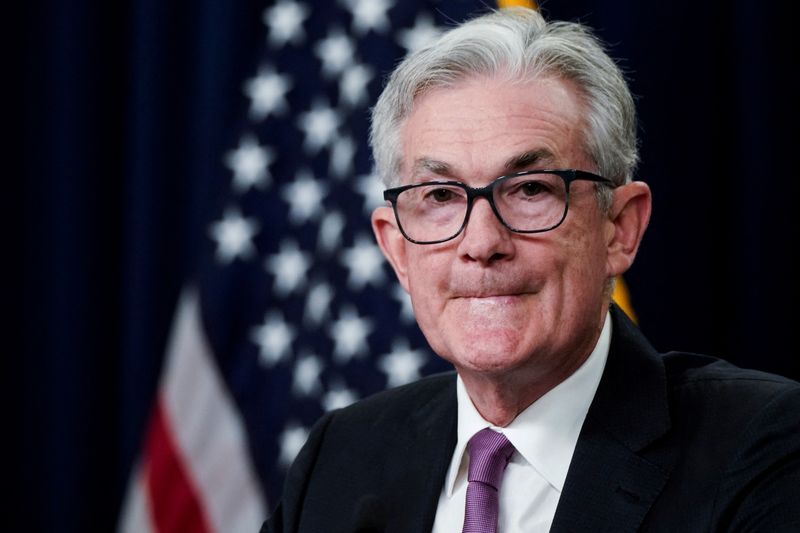By Laura Sanchez
Investing.com - European markets are in the red, with the Ibex 35, CAC 40, and DAX awaiting the macroeconomic event of the day: the interest rate decision of the US Federal Reserve (Fed) at 14:00 ET (19:00 GMT).
The consensus expects a 50 basis point hike, to a range of 4.25%-4.5%, after accumulating +375 bps of hikes since last March (four hikes of +75 bps each).
The market's attention is also focused on the press conference with Chairman Jerome Powell, scheduled for 14:30 ET.
Analysts are mixed on the Fed's 'tone' today.
"This moderation in the number of hikes is supported by some moderation in inflation data (yesterday's CPI November +7.1% YoY headline vs +7.3%e, +7.7% previously and peak +9.1% in June, while core +6% YoY vs +6.1%e, +6.3% previously and peak +6.6% in September) and the deterioration of the cycle, which is expected to intensify in the coming quarters due to the delayed effect of monetary tightening on the real economy", explain analysts at Renta 4 in a note.
Link Securities adds: "We do not believe that yesterday's U.S. CPI figures are significant enough for the members of the Federal Open Market Committee (FOMC) today to change their overall view on U.S. inflation and the U.S. economy and, therefore, on their monetary policy actions."
"Moreover, we understand that the last thing the Committee wants at this point is for financial conditions in the country to ease, something that is occurring due to the rise in bond prices and the consequent retreat in their yields, so we expect Fed Chairman Jerome Powell to maintain firm talk regarding the fight against inflation, a speech that many investors, who are already beginning to discount a turn in the country's monetary policy in 2023, may not like too much," Link Securities notes.
Rate hikes, until when?
Analysts agree that the key will be to know how far the U.S. central bank intends to raise its official interest rates before ending the process of hikes.
"A reference of its intentions will be what the various FOMC members indicate in the dot plot, in which they draw how they expect official rates to behave in the coming years. It will also be interesting to know the new macro picture published by the Fed to see how the growth and inflation expectations of the institution's analysts have evolved in recent months," Link Securities comments.
"We will be awaiting the update of GDP and inflation forecasts and the foreseeable upward revision of the dot plot, insofar as the previous one, from September, pointed to a 4.6% rate ceiling, when Powell has already stated that it will be somewhat higher," Renta 4 adds.
According to these analysts, "the market is discounting additional hikes up to a target level of 4.75%-5% in the first half of 2023, with the Fed willing to sacrifice more growth and employment in exchange for controlling prices".
In their daily market report, analysts at Bankinter commented that "the scenario that investors are discounting is that the terminal rate will be at 5%, that the next hikes will be +25 bp and that in the last quarter of 2023 the first rate cut may already take place. We will see if this scenario changes after Powell's speech."
Can the Fed cool the market?
Renta 4 reminds us that "in its latest forecasts (September), the inflation estimate for 2023 remained above the target (2.8% vs. 2%) to moderate to the estimated 2.3% in 2024, while the expected GDP in 2023 was lowered to 1.2% to recover to 1.7% in 2024". They add: "We do not expect rate cuts and a return to neutral levels (3%) until inflation control is confirmed (2024). We therefore expect a rather hawkish speech (higher rates for longer) that could cool markets, especially after the recent strong rallies (stock markets +17% since mid-October, T-bond IRR -75 bps to 3.5%). Should this expectation of more hawkish discourse be confirmed, we could see some profit taking in stocks and bonds, as well as some recovery in the dollar after a depreciation since end-September of 11% to 1.06 USD/EUR."
"Services inflation is the Fed's main source of concern. The Fed needs to keep raising rates to slow demand and keep growth below potential to restore balance and control inflation. The decision to moderate the pace of rate hikes does not mean that the fight against inflation will be relaxed. It is a matter of allowing time for the accumulated tightening in monetary policy to have its effect on the economy," Bankinter concludes.
